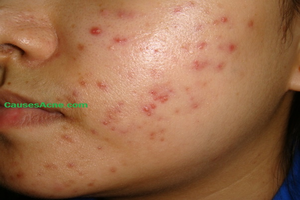
Which Type of Acne Scar Do You Have?
When you have acne, it is almost a daily struggle to treat it, prevent it and cover it up. Once it is gone, however, you can breathe a sigh of relief knowing you did everything you could do to get rid of it and it worked. But what happens when after your acne is gone, you are left with acne scars? This can be a major blow to your self-confidence and positive self-image if you are left with a face full of acne scars.
You probably know by now that when you have an acne outbreak, the last thing you should do is pick them, scratch them or scrub them off. This will most certainly lead to scarring. But sometimes acne scars develop through no fault of your own. Sometimes severe acne, once cleared up, will result in a permanent scar. Unlike regular scars that are on the skin’s surface, acne scars are deep within the skin where the inflammation originated from that produced the acne. They are a result of a healing wound in your skin which has too much collagen.
There are four common types of acne scars:
Ice pick: Ice pick scars are most often found on the cheeks. They are usually the result of acne that lead to a papule. The scars are usually deep and narrow with a jagged edge. A person with these types of scars look as if their cheeks were repeatedly stabbed with an ice pick, hence the name. Ice pick scars go as deep as the second and third layers of the skin which is what makes them very difficult to treat.
Boxcar: Boxcar scars are also deep, but are round or oval shaped with angled sides. They look similar to chickenpox scars. This type of scar is the result of a pimple that kills the skin’s collagen tissue in a specific area. Because there is no supporting tissue, the result is a sunken round or oval-shaped area on the skin. Boxcar scars run the gamut—from mild and superficial to severe and deeper. The size is dependent on how much tissue is lost. You are likely to find boxcar scars on your cheeks or temples.
Rolling: Rolling scars are different than other acne scars because the skin has sort of a wave or rolling appearance to it. These scars are a result of the bands of tissue between your skin’s surface and subcutaneous tissue underneath getting pulled. The tissues pull epidermis that is deep within the skin causing this wave-like look. Rolling scars vary in length and are difficult to treat with more common methods of scar treatment like skin resurfacing.
Hypertrophic/Keloid: A hypertrophic scar is formed when too much collagen is produced—usually as a result of wound healing. The scar becomes a red raised bump on the skin. Hypertrophic scars that are more serious are called keloid scars. A keloid scar is hypertrophic although not all large scars are considered keloid. Unlike hypertrophic scars, keloid scars can grow from outside of their area of origin. Although keloid scars are harmless, they can be painful and itchy for some people. They are most likely to occur on your chest and shoulders.
A less common form of acne scar is an atrophic scar. These are recesses in the skin that are sunken. The appearance is pitted and are caused when fat or muscle are lost underneath the skin. Most atrophic scars are caused by acne, but can also be caused as a result of chickenpox, MRSA infections, surgery or an accident.
Treatment Options
While some of these scars are more difficult to treat than others, there are options for at least diminishing the appearance of them if they cannot be removed completely. Of course, the best thing you can do is to try and keep your outbreaks of acne to a minimum as soon as they occur. Washing your face on a daily basis (especially after wearing make up or excessive sweating) with a gentle cleanser is a great place to start. You also want to stay away from abrasive scrubs and washes than can aggravate your skin and make acne worse increasing the likelihood of scars forming.
If acne scars are something that is affecting your self-confidence, causing depression or diminishing your quality of life, you should consult with a dermatologist on the best possible solutions to treat your acne scars. Even the most difficult of scars can be minimized with many of these specialized treatments. There is no reason why you have to accept your acne scars as a permanent fixture on your appearance.
